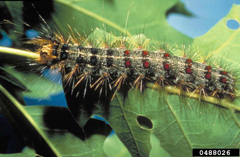Common Name
Spongy Moth
Latin Name
Lymantria dispar
Order
Lepidoptera
Family
Lymantriidae
Main Host(s): Most species of Oak (Quercus), as well as Apple (Malus), Basswood (Tilia), Willow (Salix), and many other species of trees and shrubs. It is estimated that Spongy Moth will feed upon over 500 species of trees shrubs and vines.
Life Cycle
The European Spongy Moth is found throughout Europe and in numerous locations in North America. Accidentally introduced to North America in 1869, Spongy Moth has spread across eastern North America from the Carolinas north to the Great Lakes and west to the Mississippi River. Periodically, isolated introductions have occurred in western North America.
Eggs are laid in large masses by the female moth in mid summer. As the eggs are expelled, the female sheds abdominal hairs building a protective buff coloured patch or mass of eggs about 1-2 inches in length (2.5-5.0 cm) and 0.5 to 1.0 inches (1.2-2.5 cm) in width. The eggs are laid in masses containing 200-1000 eggs, usually in protected or sheltered areas.

They may be found on the lower trunk and the underside of lower tree limbs, on nearby rocks, or even on manmade structures. The embryo develops to become a small larva within the egg which enters diapause for the overwintering stage of its lifecycle. The following spring, the larvae continue to develop and hatch. After hatching, the small first instar larvae stay close to the egg mass and within a few days begin to migrate into the upper canopy. Spinning long silken threads, the tiny larvae are readily dispersed by spring breezes throughout the surrounding forest.

The larvae move into the canopy to feed, but return to the lower areas when the daytime temperatures begin to climb. However, as the forest canopy begins to leaf out and the larvae mature, they remain in the canopy throughout the day and night, feeding voraciously. The earliest signs of defoliation will be small holes in the leaves, giving a gunshot-like appearance. As defoliation intensifies, all foliage will be consumed, and in extreme cases, the larvae will cross branches or move along the ground to find other sources of foliage.
The larvae have several stages, or instars, (five for males, six for females) with the appearance of distinctive dorsal patterns, pairs of blue and red dots, or tubercules, prominently visible in the latter stages.

The larvae pupate in a small reddish brown coloured cocoon for 7-14 days and emerge as an adult moth; moths live for about two weeks. The female moth (1.5 inches, 4.0 cm) is larger than the male and is easily recognized by white wings and distinctive black wavy V-shaped markings. She does not fly, and remains in the general area in which she emerged from her pupal case. The smaller male moth is dark brown in color with black wavy V wing markings. The males usually emerge from the pupae earlier than the females and fly about searching for females.

Impact & Damage
The European Spongy Moth, commonly referred to as Spongy Moth in North America, is found throughout the oak forests of Europe and Eurasia as well as the across the eastern sector of the North American continent. A voracious defoliator, the Spongy Moth has caused extensive damage to the oak forests of the Northeast and the Midwest US. Significant levels of oak morbidity and mortality have been recorded in areas repeatedly defoliated by the Spongy Moth.

Additionally many residential areas of the eastern USA are located within suitable host range for the Spongy Moth. Some people are allergic to the urticating hairs of the larvae and the defoliation of residential hardwood trees along with the associated debris and frass can prove stressful to property owners.
Periodically the Spongy Moth has been introduced into other areas of North America, usually west of those areas considered as generally infested. These incursions usually trigger government control and eradication efforts to help ensure that this invasive pest is limited to its current range.
Extensive defoliation can cause significant impacts on individual tree and forest health. As with many defoliators, even one year of defoliation can cause a reduction in growth and yield. Several years of defoliation can cause significant tree and stand mortality.
Resources
Learn more about Spongy Moth
Quick Links
Contact a Valent BioSciences public health representative.
Contact Us